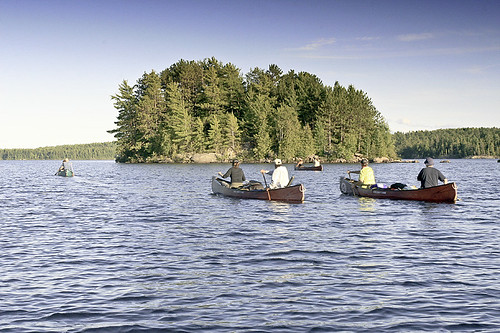 I have enjoyed myself at Nipissing University from the start, which was 19 years ago, but today pretty much took the cake. My history colleague James Murton took his environmental history class on an expedition on the Mattawa River, and allowed some other university people, including me, to tag along.
I have enjoyed myself at Nipissing University from the start, which was 19 years ago, but today pretty much took the cake. My history colleague James Murton took his environmental history class on an expedition on the Mattawa River, and allowed some other university people, including me, to tag along.The excuse for this expedition was to illustrate in a visceral way a classic theme in Canadian history, the connection between what we think of as wilderness and primeval activity in that wilderness, meaning the fur trade and the voyageur routes, and the whole world economy of the time. Every Canadian with the slightest interest in the history of his or her country has been exposed to this material in one way or another, but I will tell you it meant a great deal more to everyone who took part in today's canoe trip on the Mattawa.
Part of me says that every single course at Nipissing University that can justify a canoe trip as illustrating part of its subject matter should do so, and we could spend the entire month of September on the river. This is probably too extreme an idea, but how could it hurt? I certainly felt today that Jamie Murton had made the most of our location.
I live out in the country, and driving out to the river, and stopping at a couple of other sites (the La Vase portage and the local museum with a modern reproduction of the Montréal canoe), I found myself rather surprisingly feeling the world turning inside out. When you are living a life that involves driving between a modern home and a modern small city (with inadequate shopping but still) with a modern and quite new University, driving on modern roads and parking in modern parking lots, it is easy to get the feeling that all those trees and rocks and lakes are just in the way. If you don't like our area that feeling must be much stronger, but even I who do like it often regard the natural landscape as a barrier or empty space arranged in an inconvenient way. But even before we got to the museum or the canoes, knowing the area we were going to, I began to feel that the essential element of my world was not the road I was on, but the river I was about to tackle. I saw the landscape with whole new eyes and it was a thrill.
It reminded me of a previous time I was on the Mattawa, a summer day when I stood at the portage at Talon Dam, watching muscular young people wrestling with canoes as they carried them over a very difficult, rocky path. I realized that every summer's day since the Stone Age, this scene had been duplicated at this portage site. The wooded areas on either side of the river were of no particular interest, but this natural corridor was close to eternal. The same could be said of much of Canada. Vast areas are empty of people almost all the time, but there are corridors that are always in use. North Bay and indeed my village are on such a corridor, (North Bay on more than one), simply because if you want to get through there's not much in the way of alternatives. There are just too many rocks and trees and lakes.
Image: From Flickr, some other people on Lake Talon in 2007. It was a lot grayer and colder today, but who cares.
Great reflections Steve. Very thoughtful and true. It was an amazing day.
ReplyDeleteThis is a mental shift I know how to make in theory, because the economy of the Roman Empire and the whole history of the Viking Age make a lot more sense once you stop considering bodies of water as things in the way and start seeing them as passages. All the same, there's knowing this in theory, and then there's actually putting it to use and, for example, working out how ballast works and so on. I'm not sure punting on the Cam really does the same thing (for all that a lot of the Cambridge colleges on the river have river gates into their old kitchens because that used to be how food was shipped in...)
ReplyDelete